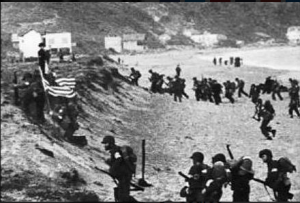Operation Torch stands, in the annals of World War II, as a defining moment that altered the course of history. This strategic military campaign, launched on November 8, 1942, marked a significant turning point in the conflict, reshaping the dynamics of the war and paving the way for future Allied successes. Let’s delve into the details of Operation Torch and its lasting impact.

The Strategic Imperative: As the war raged on multiple fronts, the Allies recognized the need for a new theater of operations to challenge the Axis powers. Operation Torch emerged as a response to this imperative, aiming to establish a foothold in North Africa and disrupt the Axis hold on the region. The primary objective was twofold: to alleviate pressure on the Eastern Front and to set the stage for further offensives into Europe.
Combined Forces, Coordinated Action: Operation Torch was a collaborative effort between American, British, and Free French forces. Led by General Dwight D. Eisenhower, the operation saw Allied troops landing at key locations along the North African coast. American forces targeted Casablanca and Oran, while the British set their sights on Algiers. The coordination and synchronization of these landings were essential for success.
The Vichy French Factor: A notable challenge in Operation Torch was the presence of Vichy French forces, which were aligned with Nazi Germany. The landings encountered resistance from these forces, as well as from the German Afrika Korps led by General Erwin Rommel. The unexpected element of surprise played a pivotal role in overcoming these obstacles.
Shifting Alliances: Operation Torch’s impact extended beyond military objectives. The Vichy French forces’ initial resistance gave way to a transformation in allegiances. Many Vichy French troops eventually joined the Free French under General Charles de Gaulle, bolstering the Allied cause and weakening Axis influence in the region.
Strategic Milestones and Legacy: The success of Operation Torch set off a chain reaction of strategic milestones. The establishment of a logistical base in North Africa facilitated subsequent Allied campaigns, including the Battle of Kasserine Pass and the eventual defeat of Axis forces. The operation also paved the way for the Allied invasion of Sicily and Italy in 1943, further advancing the Allied cause.
Operation Torch remains a testament to the power of strategic coordination, collaboration, and decisive action. This pivotal campaign not only established an Allied foothold in North Africa but also set the stage for subsequent victories against the Axis powers. Operation Torch serves as a shining example of how determined efforts and joint operations can alter the tide of history and shape the course of a global conflict.
Cite This Article
"Operation Torch: Turning the Tide in WW2" History on the Net© 2000-2024, Salem Media.
July 27, 2024 <https://www.historyonthenet.com/operation-torch-turning-the-tide-in-ww2>
More Citation Information.





